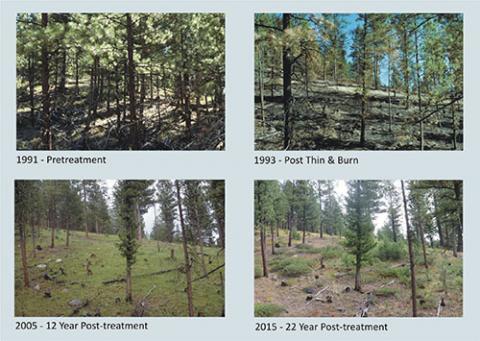See: A Century of Change in a Ponderosa Pine Forest for more information about the Historical Photopoints in the Lick Creek Drainage.
Lick Creek is the longest running fuel treatment and restoration study in the western United States. The study area is located in the northern Rocky Mountains of the United States in a ponderosa pine dominated forest. Through repeat photography and numerous published studies, we show how fuels and vegetation have changed over the 20+ years since treatment and compare the effects of harvesting with and without prescribed burning.
The Lick Creek Demonstration/Research Forest (Lick Creek) on the Darby Ranger District of the Bitterroot National Forest, Montana provides a unique opportunity to assess long-term effects of alternative cutting and prescribed burning strategies aimed at reducing fuels and moderating forest fire behavior while restoring historical stand structures and species compositions. In 1991, a cooperative venture among the Bitterroot National Forest, University of Montana, and Forest Service Intermountain Research Station (now Rocky Mountain Research Station) initiated three independent studies of thinning, retention shelterwood, and single-tree selection cuttings, with and without prescribed burning treatments. Treated units were harvested in 1992 and half of the units were prescribed burned 1 to 2 years later. Throughout the 20+ years since the treatments, numerous effects on the forest ecosystem have been studied, including: fuels, forest structure and composition, understory species responses, tree physiology, resistance to bark beetles, carbon storage, and fire hazard. Permanent photo points established in each study also visually document forest and fuel change over time.
The goals of the initial project were to increase knowledge of forest vegetation and fuel dynamics following restoration treatments, study how these differ among restoration treatment alternatives, and gain understanding of the efficacy and longevity of prescribed treatments. Study results have provided managers with guidelines for restoring ponderosa pine systems in the northern Rocky Mountain region.
In 2015 the Joint Fire Science Program funded a re-measurement of the Lick Creek study plots for two of the three studies (thinning and shelterwood studies). The re-measurement added value to past data collection efforts through modern data analysis techniques to examine treatment longevity and effects on aspects of forest resilience, including resistance to bark beetle outbreaks and resilience to drought and wildfire.
The main findings of the re-measurement are, 24 years post-treatment, cutting and burning treatments have resulted in:
- Persistent increased tree growth, even during drought because trees can grow late into the summer
- Reduced tree mortality from mountain pine beetle during an outbreak in the 2000s
- Elevated cover of non-native understory plants such as spotted knapweed, though at much lower levels (average ~4%) than seen at the peak 3-5 years post-treatment
- Aboveground tree biomass (i.e., carbon storage) recovering to pre-harvest levels
- Surface and canopy fuel loads similar to untreated units
- Increased ladder fuels from saplings and seedlings
- Crowning and torching indices similar to untreated units
All data is archived and publicly available through the Forest Service Research Data archive, including treatment photoseries that document changes from pre-treatment in 1991, post-harvest, and several post-burning timesteps through 2016.
Take home messages:
- Fuel reduction and restoration treatments are most successful with a combination of cutting and burning strategies
- Single-entry fuel treatments in low-elevation dry forests will likely not remain effective for much longer than historical mean fire return intervals so maintenance/re-entry treatments are needed.
- The overstory is still dominated by ponderosa pine for all treatments, but the smaller size classes are primarily Douglas-fir, suggesting that without future disturbance, dominance will shift from shade-intolerant pine to shade-tolerant Douglas-fir-dominated forests.
- Continued monitoring of any future re-treatments is important to determine if treatment efficacy is sustained and how non-native plant species respond.
Lick Creek remains an active research site. In 2015/2016, the thinning study had a second entry thinning and the units were remeasured in 2016 to capture the immediate post-harvest effects. In 2022, the units were measured again in anticipation of conducting follow-up prescribed burns in the cut+burn units. Those burns were completed Spring and Fall of 2023. The uneven-aged study site using single tree selection with and without fire was remeasured in 2022. Additional cutting and prescribed burning in the uneven-aged and shelterwood studies are planned for as early as 2024.

